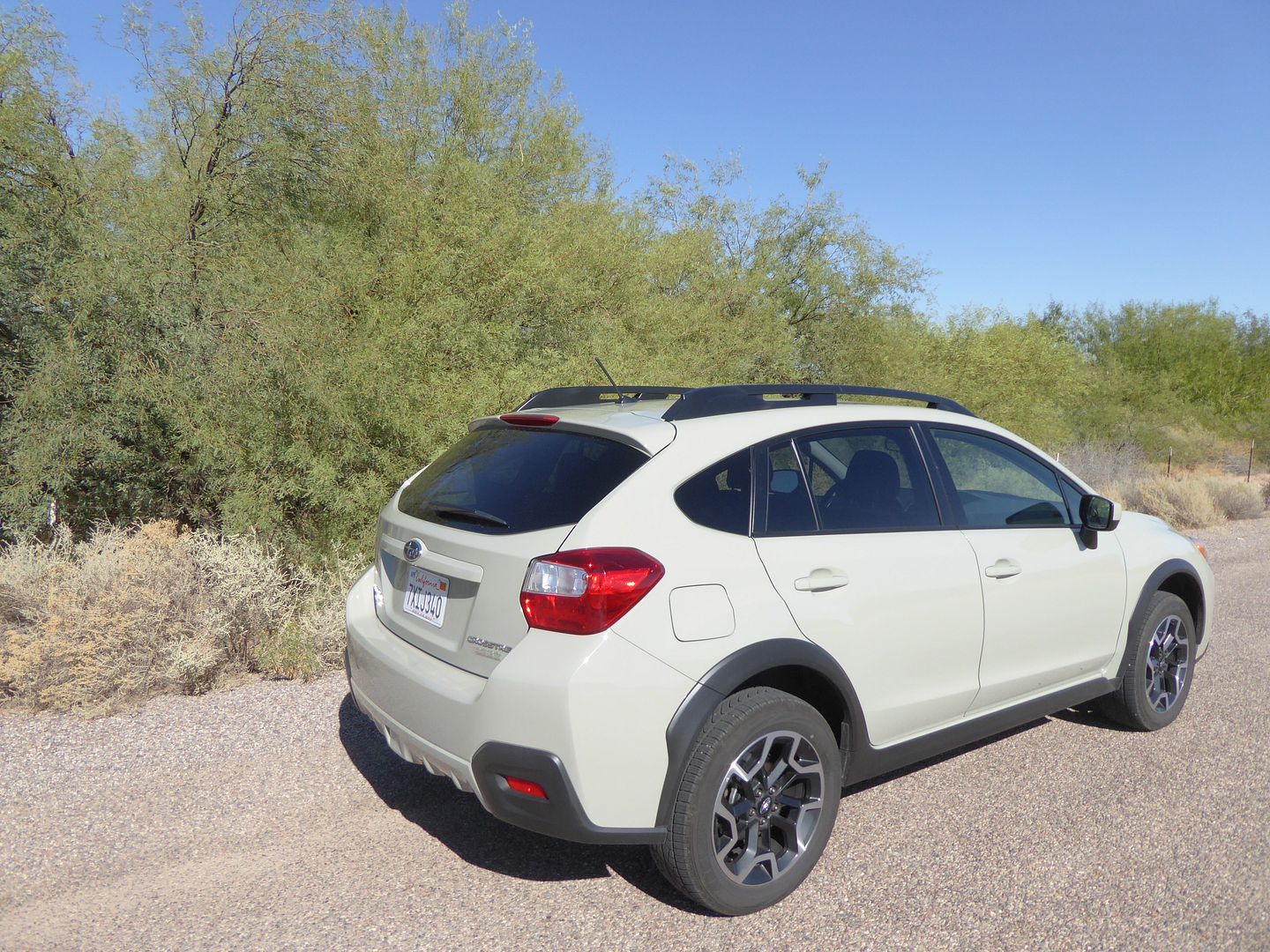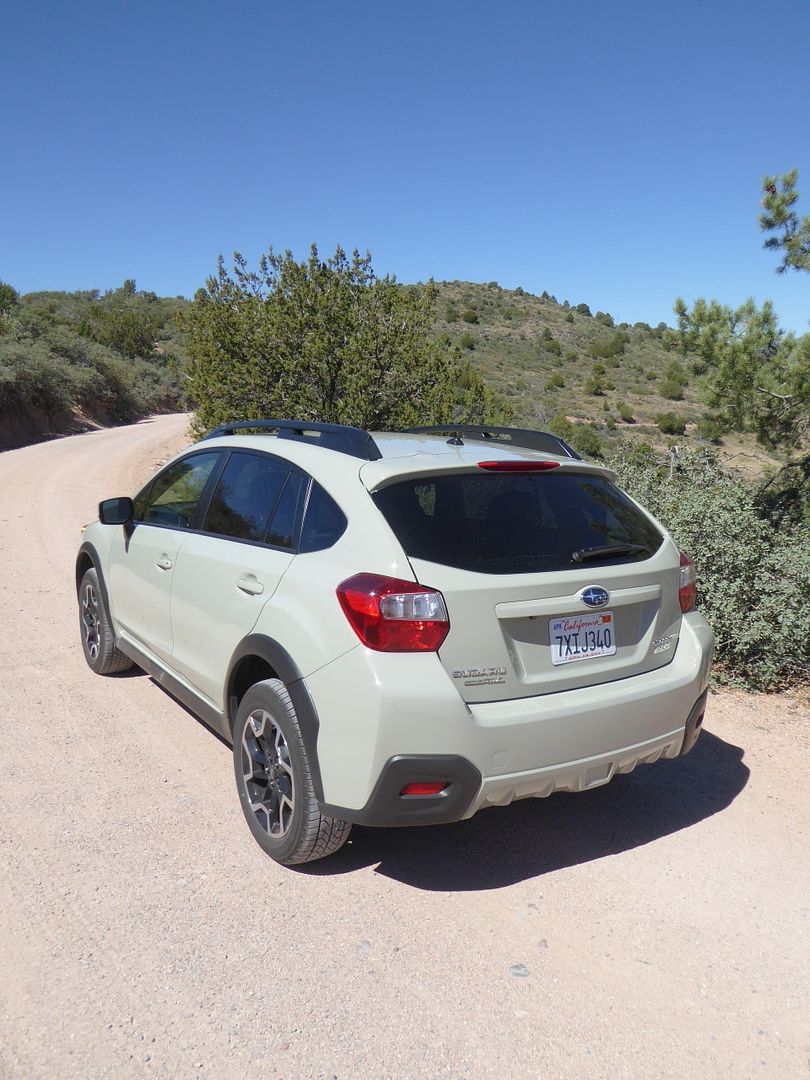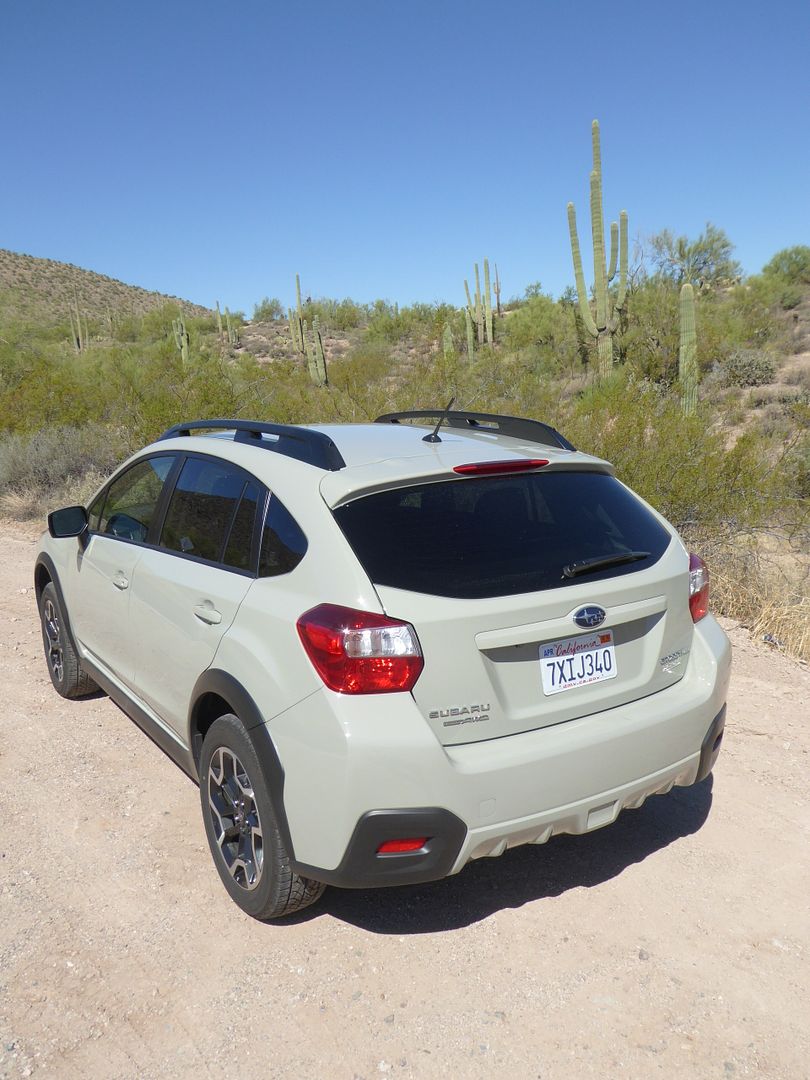



























































As has been noted whenever I do test a Subaru, these cars only appear in the rental fleets on an occasional basis, and generally in small numbers, so sourcing one to test is not easy. I had seen a rather tatty looking XV at Hertz’ Los Angeles Airport facility earlier in this trip, but it was also in a photographically challenging colour, so I had eschewed it in favour of something else. I knew that could prove to be my only opportunity to test one, of course, as I ha missed out on the related Impreza after rejecting the only example I had seen for ages as it was badly scratched, and then I never saw another one. This time luck was on my side, as when I was looking for the sixth car from a week of rentals at the Phoenix Sky Harbor facility, this car was parked in a stall where I could just get in it without even having to ask. That it was an interesting and distinctive colour, which Subaru call Desert Khaki, was an added bonus. I did not hesitate and took it to see what I thought of a car which you rarely see in Europe but which has clearly attracted American buyers in some number.
Time was when you could identify a lot of the cars on our roads just by the sound they made, without needing to see them. Those days are largely gone, but one marque retains a very distinctive sound and that is Subaru, thanks in no small measure to the fact that their cars retain their horizontally-opposed boxer engines. That characteristic noise is usually evident both outside and inside the car. So when I turned the key on this XV Crosstrek, I was expecting it to sound similar to other Subaru models that I’ve sampled. And in the confines of the rental car facility at Phoenix’ Sky Harbor airport, it did. But out on the open road, it really did not. You could say that this perhaps means that the soundproofing is such that the sounds is largely eliminated, but that’s not really the case, as there is still engine noise. And as you work the unit harder, it does get noisier. Take it beyond 4000 rpm and the engine is plain gruff. and you likely will take it to the upper part of the rev range. For two reasons. The most obvious of these would be simply to get the best out of it, and to achieve the sort of acceleration you might reasonably expect for a car of this size. The second seemed to be a consequence of the gearbox, which is a CVT unit which would would simply hang onto a given ratio for too long before adjusting to something higher. Subaru had offered a Hybrid version of the XV from 2014 to 2016 but that model was deleted for the 2017 model year meaning that all US market XV Crosstreks have the same 2.0 litre 4 cylinder engine, It puts out 148 bhp, which really is not enough to give the XV anything better than rather sluggish performance. You will have to work it hard just to keep up with the rest of the traffic especially when the car faces uphill gradients. And when you do, that Lineartronic CVT gearbox will probably frustrate you, too. The upside of the rather uninspiring performance comes at the fuel pump. I drove this car 213 miles and it needed 5.4 gallons to fill it completely at the end of the test. That equates to a very impressive 39. 44 mpg US, or 47.12mpg Imperial.
Nothing about the other driving characteristics struck me as particularly notable. Neither good nor bad. That is a bit disappointing for a product from the company that has brought us a whole lineage of enthusiast cars with WRX and STi badging, all of which started out with underpinnings that share much with this car and its predecessors, but it is almost certainly a reflection of the changed priorities at Subaru, where the focus is now very much on dependable transport rather than something aimed at the enthusiast. The steering has some feel to it, but lacks the precision that you will find in the products of cars with Ford or Mazda badges on them. Roadholding is good, of course, and there is plenty of grip, thanks to the standard permanent all-wheel drive, though you probably would not find the Crosstrek was what you would call a fun car to punt along a twisty road. I’ve not driven the equivalent Impreza on which this car is based, so cannot pronounce as to whether the raised ground clearance changes the driving experience in any significant way, but it would be reasonable to assume that with raised ground clearance, it just might. The car rides well, on the 225/55 R17 wheels that are fitted to all model variants. There were no issues with the brakes and you still get a proper pull-up handbrake fitted between the seats. I did not test the Crosstrek’s off-road credentials beyond a few dusty and gravelly spots for taking photos, but the combination of extra ground clearance and some underbody protection as well as the grip from the all-wheel drive would stand anyone in good stead who did want to take to unmetalled surfaces. The Crosstrek was certainly easy to manoeuvre. Its compact dimensions helped, and there is generally good visibility in all directions. A rear-view camera features in all 2017 model year cars and there are heated mirrors.
Gone are the days when the quality of the interior fittings of a Subaru come in for particular criticism, considerable progress in both the quality of materials and the overall design having been made in recent years with each successive model being better than the last. The end result is still not class-leading, but it is more than acceptable. A variety of materials and textures have been used in the Crosstrek, with soft feeling plastics on the dash and cloth covering most of the door casings. There is a relatively thin metal-look inlay in front of the dashboard as well as the surround to the gearlever and on the doors adding some lighter colour to the rest of the black and dark grey dash. Further colour comes from the use of orange stitching on the leather-wrapped steering wheel. The instruments are presented under a single cowl, with just two conventional dials, for the speedometer and rev counter. Fuel level is indicated by a bar chart between the two dials. There is a further reading of instant fuel consumption in the lower area of the speedometer. Further information is presented in a recessed digital display area in a moulded pod on the top of the middle of the dash. This is quite a long way from the driver, but the data in here, such as the clock is not what you would need to look at very often. More significant is the 7″ colour touch screen in the centre of the dash for the StarLink infotainment system, which appeared in the Crosstrek a couple of years ago, following its launch in the then new Legacy and Outback. There are a couple of knobs and buttons around the side of the screen for some of the audio functions, but otherwise you will need to use the touch interface. As well as AM and FM wavebands, there was Pandora radio and other screens showed a variety of other apps. You still get a CD slot above the unit. The system in the test car was upgraded from that which you will find in the entry level model, with a slightly larger screen. You also get additional speakers, though the sound system itself is actually the same. Beneath this unit are three rotary dials used for the air conditioning. As well as twin column stalks for indicators, wipers and lights, then the buttons on the steering wheel spokes complete the other minor controls, with audio repeaters on the left hand spoke and cruise control on the right. The buttons for the seat heaters were somewhat buried under the central armrest, their accessibility depending on where the armrest was positioned on its sliders. The overall effect is neat enough and it is certainly less fussy than you see in some rivals.
The seats on this car were trimmed with a mix of leather outers and a hard-wearing cloth centre. Orange stitching provides further colour contrast. Adjustment is all manual, with a height adjuster for both driver and passenger, as is the case on even the top spec cars. Power adjustment is not even an option. There is a telescoping steering column, so I was able to get a comfortable driving position. Although this may be positioned as a Crossover, in reality, it is really no taller than a regular hatch, so you do not feel that you have to step-up at all when getting in and nor do you feel the raise driving position that you would do in, say, a Subaru Forester. That said, I was happy behind the wheel, and the seat had support and grip in all the right places.
Given the relatively compact external dimensions of the Crosstrek, then space in the rear has to be described as good. With the front seats set to suit my driving position, which is well forwards, then there is a lot of legroom, but even if they are closer to their rearmost travel, there should be ample space for the occupant’s legs here. The backrest is inclined sufficiently to ensure that there is plenty of headroom even though the body of this car is not really any taller than a traditional hatchback. There is just about enough room across the width of the car for three adults, though it should be noted that there is a transmission tunnel and the console unit between the front seats extends quite a way back, so a middle seat occupant might find that their legs need to be splayed sideways a bit. Slightly surprisingly, given that this was not the base spec model, there is no central armrest, and there is only a single map pocket on the back of the front seats. There are stowage areas moulded into the door casings which could hold a bottle, though they are not that large for a lot else.
There is a reasonably sized boot which in the test car’s case had a fitted rubber flooring. There is a roller-blind style load cover. If that is in place, the boot is not that deep from to to bottom, though there is some additional space under the boot floor around the space saver spare wheel. More space can be created by dropping the asymmetrically split rear seat backrests. They rest on the rear seat cushions leaving a flat load area from the front seats to the rear of the car, a sizeable area. If you need more cargo capacity, well, there are roof rails included as standard. Inside the cabin, there is decent provision for storing odds and ends. There is a reasonable sized glovebox, bins on the doors, a lidded cubby over the driver’s left knee, a deep cubby in front of the gearlever and another area between the seats as well as a small space under the lid of the central armrest, which is on a slider.
Equipment levels have increased steadily during the life of this model. For the US market, the 2017 Crosstrek – with the XV removed from the name – comes in four different trim levels: 2.0i. 2.0i Premium, 2.0i Premium Special Edition, and 2.0i Limited. All come with the same four-cylinder engine, all-wheel drive, the Starlink infotainment system, Bluetooth, USB and auxiliary audio inputs, and a rearview camera. Of the four trims, the base Crosstrek 2.0i tenders the best value, and comes with a nice set of standard features, including roof rails, 17″ alloys, an internet streaming capability from the audio unit with standard Bluetooth and a CD slot. Be prepared to shift your own gears though, as this edition comes only with a five-speed manual transmission. For a little more money, the Crosstrek 2.0i Premium strikes a nice middle ground between price and features. Added features include what was previously available as the optional all-weather package which brings in heated front seats and mirrors and you also get a leather-wrapped steering wheel and gear knob along with the option of Subaru’s Starlink Safety and Security system (standard on the Limited) which includes an SOS button, automatic collision notification system, stolen vehicle recovery, and a vehicle monitoring app. New for 2017 is the Premium Special Edition which adds contrast stitching to the interior upholstery, gloss black accents to interior trim, keyless ignition, blind-spot monitors with rear cross-traffic alert, satellite radio, and dark grey 17-inch wheels. Premium SE models start at around $26,000. Top of the range is the Limited which gets the continuously variable automatic transmission as standard, leather upholstery, automatic climate control, an upgraded 7.0-inch touchscreen for its infotainment including navigation, and an acoustic windshield for a quieter ride. These models top out at less than $30,000, which is a good value, but they’re not necessarily luxurious.
Brand loyalty among Subaru owners is very high, but on the evidence of this one, it is hard to see why. The biggest issues for me concern the engine which is simply not powerful enough to make the car feel even moderately brisk, and the CVT gearbox which does not necessarily help the case. These disappointments aside, there were no real weaknesses at all, but equally nor was there anything which stood out as being a strength. Usually, you would say that the standard all-wheel drive is something that few if any rivals have, but in positioning this model as a Crossover rather than a standard family hatch, it is up against a whole raft of Crossovers which whilst not necessarily having this feature as standard do generally have it available as an option. And most of them are that bit more spacious inside thanks to taller bodies. Perhaps the appeal – certainly for a European – is that this car is just that bit different from those that you see on seemingly every street corner and in very supermarket car park.





















































































